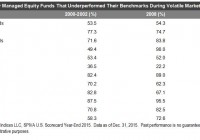Too Far, Too Fast? Market Professionals Reflect Evolving Smart-Money Opinion
How good have their forecasts been? Figure 1 is the record of five years of daily forecasts for ProShares UltraPro Dow30 ETF (NYSEARCA: UDOW ), an ETF that holds derivative securities which are intended to magnify the daily percentage price changes in the DJIA index by a factor of 3 times, either up or down. Figure 1 tells what the Market-makers daily hedging-implied forecasts for UDOW over the past 5 years have produced as net profits for a wide range of imbalances between upside and downside prospects. Those imbalances are measured by the Range Index [RI] which tells what percentage of the whole forecast range lies below the market quote at the time of the forecast. Figure 1 also indicates how often the forecasts were able to produce a profitable outcome, operating in a realistic, time-constrained portfolio management discipline. Click to enlarge So what did MMs see earlier, see now? Here is the current picture of probable coming UDOW prices, along with similar once-a-week forecasts over the past 2 years. Figure 2 (used with permission) The vertical lines of Figure 2 are the price range forecasts for UDOW implied by the MM community’s hedging actions to protect firm capital exposed during buyer~seller balancing to “fill” volume trades. The forecast of 5 weeks ago was from a then-price of $46.54 and a Range Index of -11. Now it has a quote of $64.72 and a Range Index of 57. A week ago the price of $59.49 carried a RI of 51. Figure 1 suggests that buys of UDOW at today’s RI level of 57 in the past might produce only a +2% payoff from here, instead of the upwards of +12% that had been experienced by -11 Range Index forecasts earlier. The +2% prospect is reinforced by the row of data in Figure 2 as the actual payoff experience achieved in 108 of the 1261 days for which UDOW forecasts were available. Forecasts that had RIs of around 57. The current forecast is more optimistic than past experience; it projects a potential gain of +5.6% Odds for reaching the current payoff prospect remain high, with priors producing a profit in 84 of every 100 among the 108 experiences. The fact that gains better than three times the earlier forecast’s average payoff already have been experienced makes one wonder if the “other shoe might drop” any time now and markets might start to back off. To ease such concerns, it is appropriate to know as UDOW prices were rising during this past week, its MM expectations rose faster. The outlook gains pulled back RIs which on a couple of days were at 68. Continued rising expectations, at a gain rate faster than prices, will put strength under a continued market price rise, albeit at a slower pace. Failure to do so may signal weakening market enthusiasm. We’ll have to see what happens. It can be monitored on blockdesk.com., along with expectations for the VIX index and VIX-based ETFs. Disclosure: I/we have no positions in any stocks mentioned, and no plans to initiate any positions within the next 72 hours. I wrote this article myself, and it expresses my own opinions. I am not receiving compensation for it (other than from Seeking Alpha). I have no business relationship with any company whose stock is mentioned in this article.
